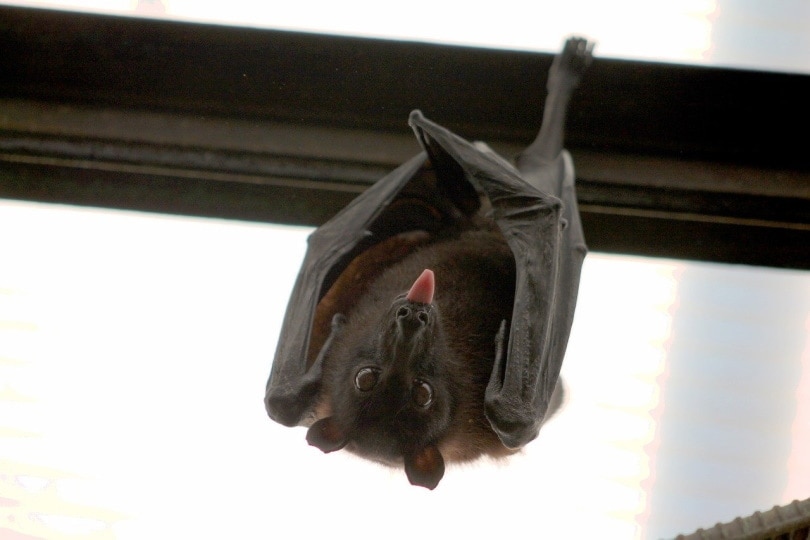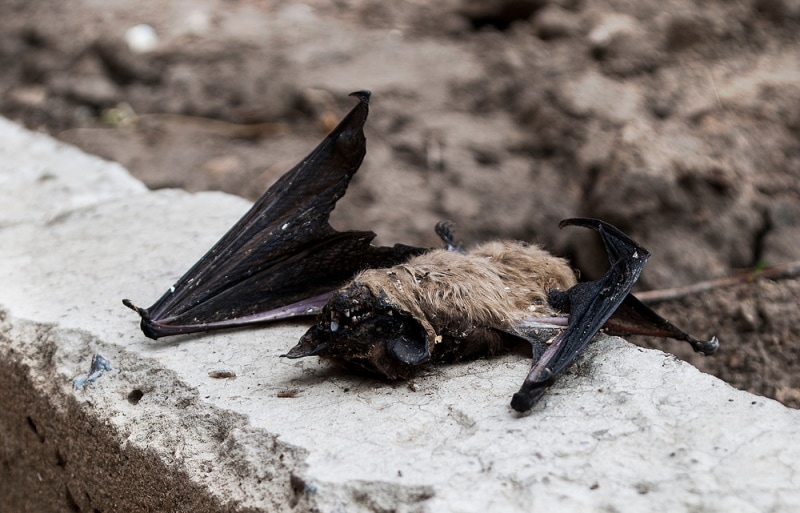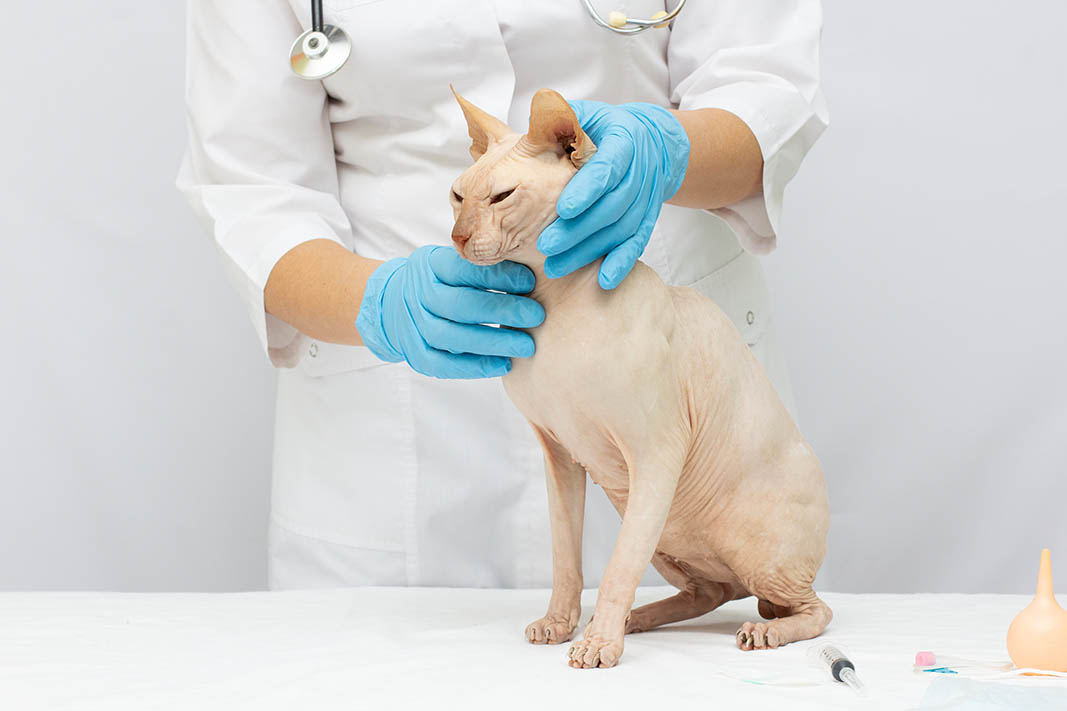My Cat Killed a Bat! 5 Vet-Approved Tips on What to Do Next

Updated on

Click to Skip Ahead
Despite their love for canned tuna and soft beds, cats are still one of nature’s finest predators. They’ll hunt anything and everything they can, whether that’s your hand, a mouse toy, or given the chance, small live animals like bats.
Coming home to a dead bat next to your smug cat can be shocking, but try not to panic. In most cases, your cat is likely going to be safe after killing a bat, but there are important considerations and precautions that need to be taken. Contact your veterinarian and a doctor immediately, who will advise you on the next steps in order to protect your health and your cat’s, particularly from rabies.
The 5 Things to Do After Your Cat Kills a Bat
Bats are known to carry infectious agents like rabies, ebola, coronavirus, salmonellosis, leptospirosis, and many more, so keep the following precautions in mind:
1. Keep everyone else away from your cat and the dead bat
First, quarantine your cat and the dead bat away from everyone else in your home. This can be as simple as initially shutting your cat in a separate room or putting them in a cat carrier or their crate.
You don’t want other household pets trying to play with the dead bat or attempting to eat it, nor do you want to risk your cat accidentally scratching a family member while playing with them.

2. Secure the bat carcass carefully.
Your first instinct may be to throw away the bat, but refrain from doing so. For one, improper handling can spread any existing germs from the bat to other surfaces. Scavenging animals can get into trash cans, further spreading any pathogens.
In addition, the dead bat should also be tested for rabies, so you can be certain that your cat (and family) isn’t at risk. Local wildlife experts may also want to retrieve the bat for further examination.
- Wear scratch-proof gloves before handling the dead bat. As an extra precaution, wear disposable gloves on top of that so the bat never comes into contact with your bare skin.
- Prepare a container for the carcass. You can use a cardboard box with a lid, thick plastic bags or Ziplock (double- or triple-bag it!), or an old Tupperware container you’re happy parting with.
- Put the bat in the container and seal it tightly.
- Place the container somewhere secure. You don’t want other animals, kids, or adults to accidentally come into contact with the bat while it’s stored in your home (or anywhere else).
- Make sure you dispose of any gloves, bags, or containers used to handle the bat.
- Disinfect any surfaces the bat may have been in contact with. This includes floors, furniture, walls, and windows where your cat may have dragged the bat to. Don’t forget to clean and disinfect the cat carrier (or whatever you used to contain your pet) as well.
- Wash your hands thoroughly and multiple times, then disinfect them with an antiseptic or hand sanitizer.
3. Call for professional assistance.
After securing the dead bat, contact the relevant authorities.
- Animal Control
- Your local health department
- Your state wildlife agency
- Bat conservation/rehabilitation agencies near you
Some states even have an official bat reporting website, such as this one for Oregon. You can also call a local bat rescue for help.
They’ll be able to advise you on the best way to handle the bat and, in many cases, arrange for retrieval and testing of the bat.

4. Call your vet and a medical professional.
Bats are currently the leading cause of rabies in the US, and while not all bats carry the virus, it’s a risk you don’t want to take lightly.1
There’s also no way of knowing what happened while your cat was hunting down the bat; they may have been scratched or bitten. Even the tiniest wound from a rabies-infected bat can lead to transmission of this fatal illness.
Call your vet as soon as possible and discuss the likelihood of rabies exposure. Depending on your cat’s age and vaccination history, they may require additional boosters or quarantining at home.
Your vet can also check your cat for other injuries and recommend the safest course of action for you and your cat, but they will also strongly advise you to contact your doctor immediately for particular precautions when it comes to protecting your own health.
Finally, if you or any other family members were in the vicinity when this incident happened, your doctor may recommend rabies post-exposure prophylaxis (PEP). This is a course of vaccinations and human rabies immune globulin that can help prevent infection in case of exposure.
5. Look out for any changes in your cat’s behavior.
Monitor your pet for any changes in their behavior or health over the next 45 days if they are up to date with their rabies injections, or for as long as 4 months if they are not, but largely based on your vet’s advice.
- Changes in behavior
- Unexpected nervousness or shyness
- Excitement
- Muscle spasms
- Difficulty swallowing
- Excessive drool
- Paralysis or weakness
Take your cat to the vet immediately if you notice any of these signs, or even if you just think your cat isn’t quite right.

The 4 Ways to Protect Your Cat from Bats (and Vice Versa)
Bats and cats don’t have a natural prey/predator relationship. In fact, bats are predators themselves, and quite helpful ones at that!
Their primary prey is insects, most of which are pests. Some studies have found that pest consumption by bats saves the agriculture industry around $3 billion a year. They also assist in pollination and seed dispersal for many plant species.
On the other hand, cat attacks are responsible for many bat deaths and injuries. Pet cats, in particular, simply do it for fun.
Therefore, it’s in the best interest of both your cat and the local bat population to manage the situation correctly. Use these tips:
1. Keep your cat strictly indoors.
The most effective way to prevent wildlife-related incidents is to keep your pet inside. Indoor cats are also less prone to accidents and injuries and are much better protected from the elements.
2. Keep your cat indoors at night.
If you don’t want to keep your cat indoors 24/7, consider bringing them in at night. Bats typically emerge from their roosts two to three hours after dusk to hunt and feed. After that, they’ll fly home to sleep.
Bring your cat in half an hour before sunset and secure them indoors for at least a few hours after. This should minimize the opportunities your pet has to hunt bats.

3. Attach a bell to your cat’s collar.
Adding a bell to your cat’s collar can help alert bats and other wildlife of their presence. That way, if your cat does try to hunt, the bat has more time to fly away and avoid contact.
We all know how curious cats can be! Keep your cat safe with our Hepper Breakaway Collar, made of 100% natural hemp. This collar's quick-release mechanism will make sure your cat never gets stuck, and the metal slip-locks will ensure a tight fit for any breed. Plus, the included jingle bell will protect your local wildlife.
- Hemp-Hemp Hooray - hemp breakaway cat collars are long-lasting and resistant to UV rays – The...
- What the neck?! - Our cat breakaway collar has adjustable sizing with metal slip-locks, and softens...
4. Bat-proof your home and property.
Bats are drawn to dark, quiet places like cavities in trees or man-made structures. It’s not uncommon for bats to find their way into homes and other buildings, often through cracks in the walls or crevices around windows.
If your cat caught the bat from a hidden roost in your house, call a professional ASAP. They can remove the bats safely, seal up any entry points, and help you prevent further incidents.
Reduce bat attractants in and around your property as well. For example, keep compost and food waste away from the house, clean up spilled birdseed, and keep pet dishes covered.
In Conclusion
It’s impossible to suppress your cat’s hunting instincts, unless they are kept indoors, but knowing what to do if your cat kills a bat can reduce the risk of rabies, infections, and other injuries that can result from the encounter.
Act fast the moment you discover your pet has attacked or killed a bat. Keep everyone else away from the area, secure your cat, and carefully secure the carcass. Then, call your vet, a doctor, and a relevant wildlife agency for further instructions.
At the same time, bats are protected by law and are essential to our ecosystem. Taking steps to protect them from cats is not just ethical, but also the responsible thing to do as a pet owner. Remember to keep your pet indoors, especially in the evening, bell their collars, and bat-proof your home to prevent wildlife encounters.
Featured Image Credit: jochemy, Pixabay














